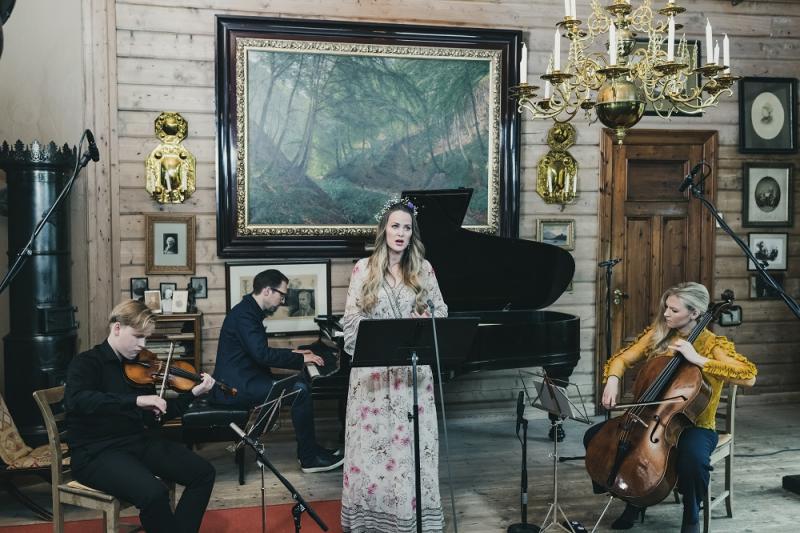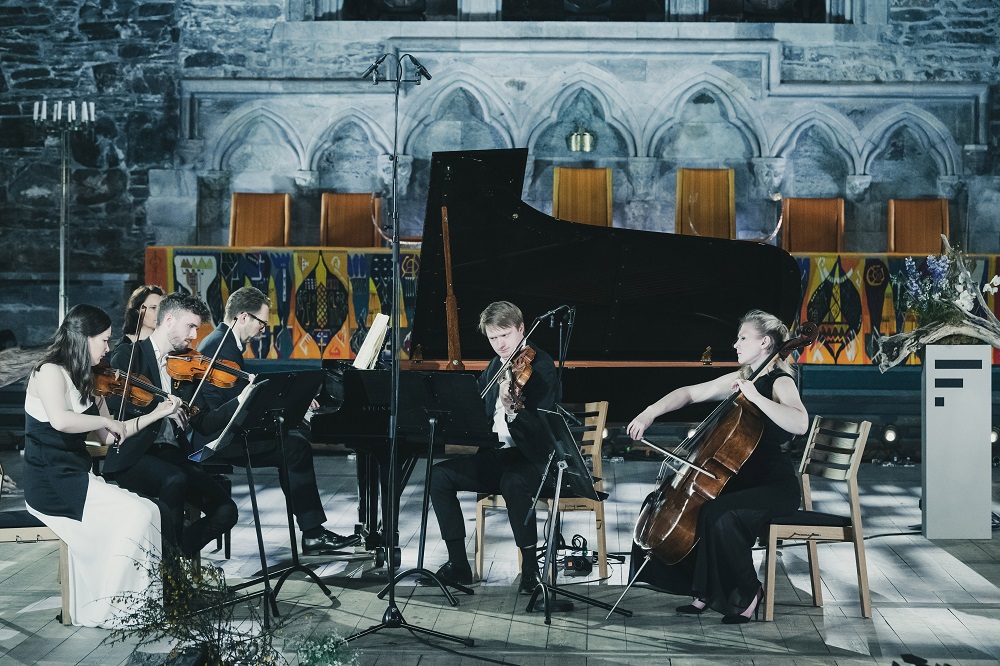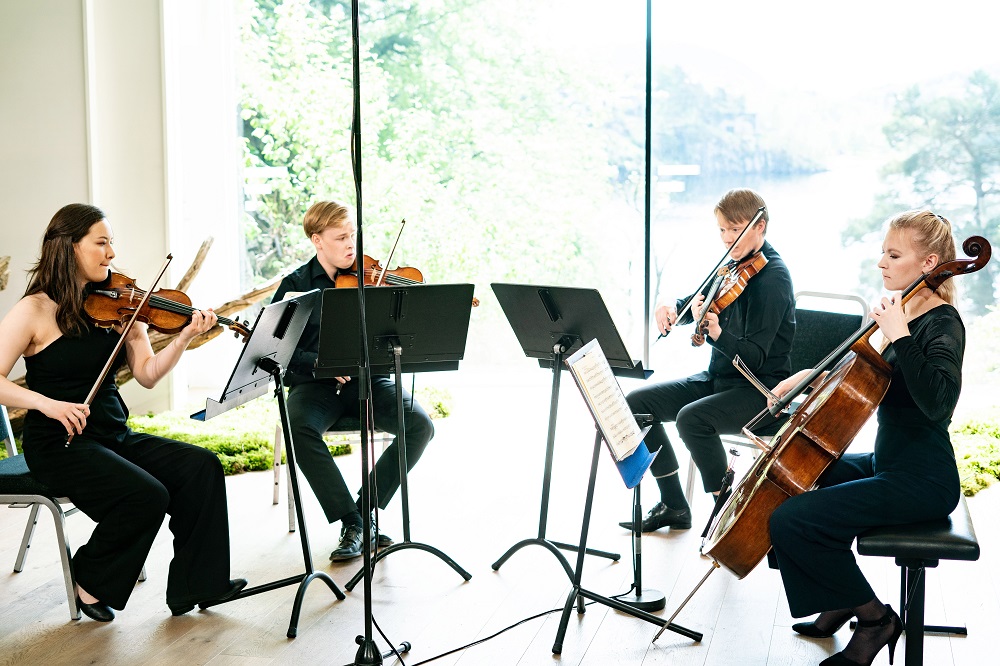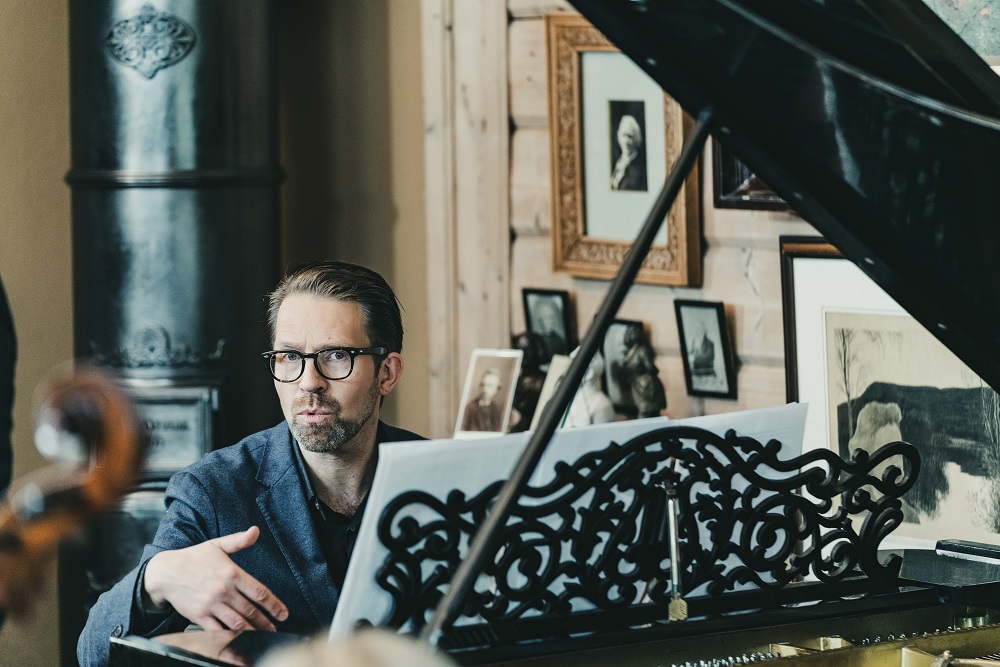Andsnes, Eriksmoen and friends, Bergen International Festival online review - from Mozart to Widmann | reviews, news & interviews
Andsnes, Eriksmoen and friends, Bergen International Festival online review - from Mozart to Widmann
Andsnes, Eriksmoen and friends, Bergen International Festival online review - from Mozart to Widmann
Youth and experience perfectly blended in three outstanding chamber concerts

This is as close as we’re going to come now to the real festival experience. The enviably well-funded Bergen International Festival is serving up on average three or four events a day, livestreamed from atmospheric venues around the city and all available for a month.
Nevertheless, the all-Schumann programme in the Håkonshallen was the most immediate and moving online concert I’ve witnessed so far – and that with excellent offerings from Oslo, Prague and Stockholm. The composer’s elegiac side means that tears are never far away, but the absolute miracle here was Andsnes’ support for Eriksmoen in a selection of Lieder from the Myrthen (Myrtles) set. Her fresh, youthful soprano has surprising reserves of strength which were briefly unleashed here; but above all what a joy it must have been for her to coast above and alongside piano-playing of this suppleness and mastery, above all in “Der Nussbaum” (“The Nut-Tree") with its heartleap refrains. The familiar “Widmung” (“Dedication”) sounded like a new song, the originality of the piano lines leaping out.  Andsnes’ partnership with young cellist Sandra Lied Hage in the Five Pieces in Folk Style at the start of the concert was equally fine-tuned; her introspection suited most of the music, but Norwegian reserve wasn’t entirely overcome. Which it was, and with smiling, complicit exuberance, by her four fellow-Crescendists in the great Piano Quintet: violinists Sonoko Miriam Welde and Edvard Erdal, viola-player Eivind Ringstad (already well establshed on the international scene) and a cellist of stronger presence, Amalie Stalheim (pictured above with Andsnes). The slow movement is so apt to our feelings at the moment, the sombre-wistful Funeral March lit up by the rays of subtle, billowing hope in the major-key sequences. Watch the Håkonshallen concert here.
Andsnes’ partnership with young cellist Sandra Lied Hage in the Five Pieces in Folk Style at the start of the concert was equally fine-tuned; her introspection suited most of the music, but Norwegian reserve wasn’t entirely overcome. Which it was, and with smiling, complicit exuberance, by her four fellow-Crescendists in the great Piano Quintet: violinists Sonoko Miriam Welde and Edvard Erdal, viola-player Eivind Ringstad (already well establshed on the international scene) and a cellist of stronger presence, Amalie Stalheim (pictured above with Andsnes). The slow movement is so apt to our feelings at the moment, the sombre-wistful Funeral March lit up by the rays of subtle, billowing hope in the major-key sequences. Watch the Håkonshallen concert here.
With one change of violinist – Ludvig Gudim taking over from Erdal – the Crescendo performers excelled themselves in the second concert, from the state-of-the-art small hall built on Grieg’s Troldhaugen estate with its window out on to trees and water (there’s been some development around this inlet, but it’s still beautiful). The familiar west-coast rains eventually yielded to sunshine in the scene beyond, creating some difficulties of lighting for the otherwise superb camerawork, as the quartet music became more embattled, from stylishness and elegance in Mozart’s “Hunt” Quartet – Welde properly found her well-turned feet for the sudden depths of the Adagio – to featured festival composer Jörg Widmann’s Third with the same title (the Crescendo quartet pictured below).  It rollicks from crazy takes on Schumann to obsession with the dactyllic rhythms familiar from Beethoven’s Seventh and Ninth, making it a curious companion-piece to John Adams’s Absolute Jest for string quartet and orchestra. But this is more vocal – literally, as the players shout and shriek, three of them eventually turning on the cellist in a violent endgame. Nothing less than total togetherness and a wildness these Norwegians seem to be able to access will do; superlative work here from the four young players.
It rollicks from crazy takes on Schumann to obsession with the dactyllic rhythms familiar from Beethoven’s Seventh and Ninth, making it a curious companion-piece to John Adams’s Absolute Jest for string quartet and orchestra. But this is more vocal – literally, as the players shout and shriek, three of them eventually turning on the cellist in a violent endgame. Nothing less than total togetherness and a wildness these Norwegians seem to be able to access will do; superlative work here from the four young players.
Andsnes had a less rewarding task with Widmann’s Idyll and Abyss; somehow Schubert’s late piano sonatas handle those extremes more effectively than this mix of pastiche and seeming improvisation. Watch the Idyll and Abyss concert here. The opener, Schubert’s yodelling Scherzo D593 No. 1, was paralleled by the opening number in the house itself the following day: Beethoven’s Tyrolean in a sequence of his folk songs arranged for piano trio with voice. Andsnes played Grieg’s Steinway beneath the striking painting of a Danish lane by Gotthard Christensen, as he had in a programme of Liszt and Kurtag I attended here in 2008 .Eriksmoen plumbed the full sadness of “The Sweetest Lad was Jamie” – one of several Scottish numbers here homaging Grieg’s ancestry (the family name was Greig, of course, when his great grandfather emigrated to Norway). “Auld Lang Syne”, with a neat little twist in the instrumental coda, and one of Beethoven’s several quirky homages to “God Save the King” made an amusing mesalliance.  Then we had Welde and Gudim in a wide-ranging selection of violin duos from Bartók’s set of 44, the pair’s sparkling engagement and eye-contact a joy to watch, with Welde operating the pedal to turn her iPad pages with rhythmic exuberance. And if Hage brought more inwardness to Beethoven’s early C minor Piano Trio (Op. 1 No. 3 than it always needed, Andsnes (pictured above) kept it light and flowing, while Gudim’s precociously cultured playing was a revelation. Watch the Grieg house recital here. What a powerhouse of world-class string players Norway is nurturing; all the more thanks to the government and enlightened institutions like Oslo's Barratt-Due Institute of Music for valuing continuity of culture. As that comes under serious threat elsewhere in the world, it’s good to know at least one country which will ensure it goes from strength to strength.
Then we had Welde and Gudim in a wide-ranging selection of violin duos from Bartók’s set of 44, the pair’s sparkling engagement and eye-contact a joy to watch, with Welde operating the pedal to turn her iPad pages with rhythmic exuberance. And if Hage brought more inwardness to Beethoven’s early C minor Piano Trio (Op. 1 No. 3 than it always needed, Andsnes (pictured above) kept it light and flowing, while Gudim’s precociously cultured playing was a revelation. Watch the Grieg house recital here. What a powerhouse of world-class string players Norway is nurturing; all the more thanks to the government and enlightened institutions like Oslo's Barratt-Due Institute of Music for valuing continuity of culture. As that comes under serious threat elsewhere in the world, it’s good to know at least one country which will ensure it goes from strength to strength.
- Links to viewing of all three concerts given above. Andsnes will appear in the closing concert on 5 June, while he and Eriksmoen can also be seen in the opening concert
- Bergen International Festival website
- Read more classical reviews on theartsdesk
rating
Explore topics
Share this article
The future of Arts Journalism
You can stop theartsdesk.com closing!
We urgently need financing to survive. Our fundraising drive has thus far raised £49,000 but we need to reach £100,000 or we will be forced to close. Please contribute here: https://gofund.me/c3f6033d
And if you can forward this information to anyone who might assist, we’d be grateful.

Subscribe to theartsdesk.com
Thank you for continuing to read our work on theartsdesk.com. For unlimited access to every article in its entirety, including our archive of more than 15,000 pieces, we're asking for £5 per month or £40 per year. We feel it's a very good deal, and hope you do too.
To take a subscription now simply click here.
And if you're looking for that extra gift for a friend or family member, why not treat them to a theartsdesk.com gift subscription?
more Classical music
 Bizet in 150th anniversary year: rich and rare French offerings from Palazzetto Bru Zane
Specialists in French romantic music unveil a treasure trove both live and on disc
Bizet in 150th anniversary year: rich and rare French offerings from Palazzetto Bru Zane
Specialists in French romantic music unveil a treasure trove both live and on disc
 Scottish Chamber Orchestra, Ibragimova, Queen’s Hall, Edinburgh review - rarities, novelties and drumrolls
A pity the SCO didn't pick a better showcase for a shining guest artist
Scottish Chamber Orchestra, Ibragimova, Queen’s Hall, Edinburgh review - rarities, novelties and drumrolls
A pity the SCO didn't pick a better showcase for a shining guest artist
 Kilsby, Parkes, Sinfonia of London, Wilson, Barbican review - string things zing and sing in expert hands
British masterpieces for strings plus other-worldly tenor and horn - and a muscular rarity
Kilsby, Parkes, Sinfonia of London, Wilson, Barbican review - string things zing and sing in expert hands
British masterpieces for strings plus other-worldly tenor and horn - and a muscular rarity
 From Historical to Hip-Hop, Classically Black Music Festival, Kings Place review - a cluster of impressive stars for the future
From quasi-Mozartian elegance to the gritty humour of a kitchen inspection
From Historical to Hip-Hop, Classically Black Music Festival, Kings Place review - a cluster of impressive stars for the future
From quasi-Mozartian elegance to the gritty humour of a kitchen inspection
 Shibe, LSO, Adès, Barbican review - gaudy and glorious new music alongside serene Sibelius
Adès’s passion makes persuasive case for the music he loves, both new and old
Shibe, LSO, Adès, Barbican review - gaudy and glorious new music alongside serene Sibelius
Adès’s passion makes persuasive case for the music he loves, both new and old
 Anja Mittermüller, Richard Fu, Wigmore Hall review - a glorious hall debut
The Austrian mezzo shines - at the age of 22
Anja Mittermüller, Richard Fu, Wigmore Hall review - a glorious hall debut
The Austrian mezzo shines - at the age of 22
 First Person: clarinettist Oliver Pashley on the new horizons of The Hermes Experiment's latest album
Compositions by members of this unusual quartet feature for the first time
First Person: clarinettist Oliver Pashley on the new horizons of The Hermes Experiment's latest album
Compositions by members of this unusual quartet feature for the first time
 Gesualdo Passione, Les Arts Florissants, Amala Dior Company, Barbican review - inspired collaboration excavates the music's humanity
At times it was like watching an anarchic religious procession
Gesualdo Passione, Les Arts Florissants, Amala Dior Company, Barbican review - inspired collaboration excavates the music's humanity
At times it was like watching an anarchic religious procession
 Classical CDs: Camels, concrete and cabaret
An influential American composer's 90th birthday box, plus British piano concertos and a father-and-son duo
Classical CDs: Camels, concrete and cabaret
An influential American composer's 90th birthday box, plus British piano concertos and a father-and-son duo
 Cockerham, Manchester Camerata, Sheen, Martin Harris Centre, Manchester review - re-enacting the dawn of modernism
Two UK premieres added to three miniatures from a seminal event of January 1914
Cockerham, Manchester Camerata, Sheen, Martin Harris Centre, Manchester review - re-enacting the dawn of modernism
Two UK premieres added to three miniatures from a seminal event of January 1914
 Kempf, Brno Philharmonic, Davies, Bridgewater Hall, Manchester review - European tradition meets American jazz
Bouncing Czechs enjoy their Gershwin and Brubeck alongside Janáček and Dvořák
Kempf, Brno Philharmonic, Davies, Bridgewater Hall, Manchester review - European tradition meets American jazz
Bouncing Czechs enjoy their Gershwin and Brubeck alongside Janáček and Dvořák
 Solomon, OAE, Butt, QEH review - daft Biblical whitewashing with great choruses
Even a top soprano and mezzo can’t make this Handel paean wholly convincing
Solomon, OAE, Butt, QEH review - daft Biblical whitewashing with great choruses
Even a top soprano and mezzo can’t make this Handel paean wholly convincing

Add comment